|
चित्रनिबंध - भारतीय पक्षी (भाग - 3 ) |
|
Photo essay : Indian Birds (Part 3)
|
|
December 2011 |
|
Please use minimum 1280 pixel horizontal screen
resolution for viewing. Please be patient while all the images in
webpage are loaded. |
|
Please do not use the images for any commercial
use without permission. Text in Marathi and English is not exact
translation. |
|
KEEP AUDIO VOLUME LOW
|
|
|
|
|
आपण भारतासारख्या निसर्ग विविधतेने नटलेल्या देशाचे नागरिक आहोत, हे भाग्य आहे. आपल्या देशातील विविध प्रांतवार हवामान,
व अधिवासाचे विविध प्रकार यामुळे, येथे नाना जातीचे पक्षीगण आढळतात. भारतात अंदाजे १२०० जातीचे पक्षी आढळतात. आपल्या महाराष्ट्र राज्यातच यातील ५५० जातीचे पक्षी दिसतात. यातील बरेच पक्षी निवासी आहेत. तर काही जातींचे पक्षी हिवाळ्यात आपल्या कडे पाहुणे असतात.
दुर्दैवाने आपल्या वेंधळट प्रगती, औद्द्योगिकरणामुळे आपली निसर्ग संपत्ती लोप पावत आहे. प्रदुषण, जंगलतोड, शिकार व हवामान बदलांमुळे बरेच पक्षी दुर्मिळ होत आहेत. शहरात चिमण्या, गावाकडे गिधाडे, माळरानावरचा माळढोक, असे खुप जातीचे पक्षी नामशेष होण्याच्या मार्गावर आहेत. मनुष्यप्राणी हा जसा बऱ्याचदा मारक ठरतो तसाच तो तारक सुद्धा होऊ शकतो.
|
|
India is a land with wide range of weather conditions and habitats. Various types of avian fauna is seen in India. About 1200 species of birds are seen in India. Many of these birds are resident birds of India, some are the migratory birds which travel from central asia in winter. Unfortunately due to chaotic haphazard policies of urban development and human wildlife conflicts, India is loosing fauna species rapidly. The Great Indian bustard from the arid grasslands, the vulture species and many other birds are endangered due to human activities disturbing the important links in our ecosystem.
|
|
|
| |
<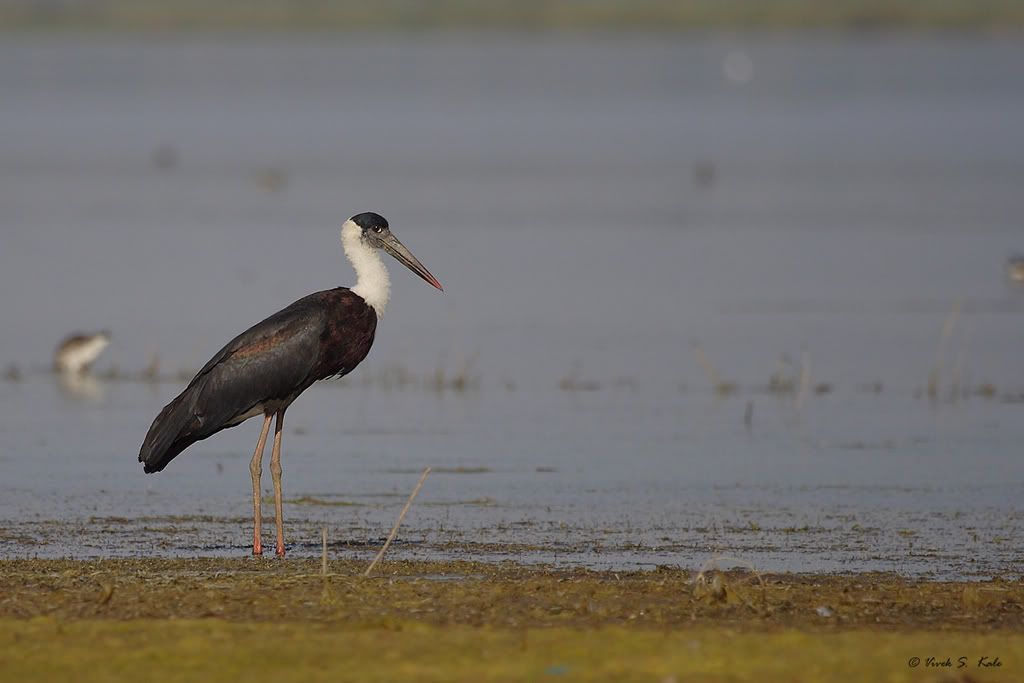 |
| |
| Ciconia episcopus, Wooly Necked Stork,पांढऱ्या मानेचा करकोचा , marshy water bodies, Maharashtra, Pune district, November 2011
|
| |
|
|
पांढऱ्या मानेचा करकोचा आपल्याला शेतात, पाणथळ ठिकाणी हमखास दिसणारा पक्षी आहे. सहसा तो दुकटा अथवा चार-पाच च्या गटात दिसतो. पाणथळ ठिकाणाजवळच झाडावर तो त्याचे घरटे करतो. रंगाने तो दुरुन काळा दिसत असला तरी त्याच्या अंगावर छाती कडे जांभळी चकाकणारी झालर असते. पाठीवर हिरवट काळी चकाकी असते. डोक्यामागे व गळ्यात त्याला सफेद पिसे असतात. लहान वयात हा सफेद झुपका जास्त असतो. वय वाढेल तसा हा सफेद झुपका कमी होतो. पाण्यातले किडे, मासे, बेडुक हे त्याचे प्रमुख खाद्य आहे. त्याचे डोळे बटबटीत जांभळट तांबुस रंगाचे असतात. चोच काळी व टोकाकडे तांबुस असते. पाय लालसर असतात. उंचीस हा पक्षी अंदाजे ८० से.मी. असतो.
|
|
Ciconia episcopus, is a large stork about 80 cm in height. It is a shining black colored bird, with white wooly neck and white belly. The breast and lesser wing coverts are purple glossed. The abdomen is Bronze-green glossed. The plumage is green-blue glossed. Its eyes are large, with crimson iris.
Its bill is black with crimson-red at the tip.Its legs and feet are red.
The extent of white wool on its neck varies as per its age. The younger birds have more wool than the elder ones.
The bird is often seen soaring high in thermals. It is seen in small flocks. It is seen in the marshy area, fields, ponds with trees. The bird is seen in Most of the Indian planes. In Marathi the bird is known as Pandhara Karkocha, for its white woolen neck.
The word episcopus means the person who looks at/thinks about something intensely.
Epi means intensely and scopus means looks into. The greek word episcopus was used for the bishops in the church. The episcopus used to wear black dress with white cloth around their neck. Hence from this dress, of clerics from the past, for the similarity with the bird avatar, the bird is known as Ciconia episcopus. Ciconia is a genus of birds in the stork family.
|
|
|
|
|
< |
| |
| Ciconia episcopus, Wooly Necked Stork,पांढऱ्या मानेचा करकोचा , marshy water bodies, Maharashtra, Pune district, November 2011
|
| |
< |
| Dicrurus macrocercus, Black Drongo, कोतवाल, Open country, Maharashtra, Pune district
|
| Habitat : Open country, resident
|
|
|
कोतवाल हा एक काळ्या रंगाचा, लाल डोळ्याचा व डोळ्याजवळ सफेद ठिपका असलेला शेतात, गावातील वनराईत हमखास दिसणारा पक्षी होय. झाडाच्या व झुडुपाच्या शेंड़्यावर बसुन राखण करयाच्या त्याच्या प्रवृत्तीमुळे त्याला कोतवाल असे नाव मिळाले आहे. त्याच्या भागात व घरट़्याच्या परिसरात घुसखोरी करणाऱ्या शिकारी पक्ष्यांना हा पक्षी हुसकावतो. नांगरणी झालेल्या शेतात वा तण जाळलेल्या रानमाळावर तो किडे पकडताना हमखास दिसतो. चरणाऱ्या शेळ्यांवर, हरणांवर स्वार होऊन तो चरताना जमिनीतुन बाहेर पडणाऱ्या किड़्यांवर त्याची नजर असते. दुरुन येणाऱ्या श्वापदांवर लक्ष्य ठेवित चरणाऱ्या जनावरास सावध करण्याची त्याला सवय असते. त्यामुळे त्याचे "एकमेका सहाय्य करु" असे या चरणाऱ्या प्राण्यांशी संबंध आहेत असा समज आहे. बरेच लहान पक्षी कोतवालाच्या कोतवालीचा उपयोग करत त्याचा आश्रय घेतात.
|
|
Black drongo, is black in color with dark blue gloss. Its iris is dark crimson brownish, and it has a small white spot near gape. The birds feed on insects mid air and close to ground. The bird perches on prominent perch. In Marathi the bird is known as kotwal meaning a policeman. The bird boldly protects its juveniles and others by fierce fully chasing out the intruders. It is often seen close to the wild fire in the grass/forest. It feeds on the insects coming out of the fire. It is also seen in agricultural land while the farmers plough the field. It has a social understanding with many other grazing animals such as sheeps, dears, cows and buffalos etc. As these animals graze or disturb the ground otherwise, the drongos feed on the insects available due to disturbance in soil. Drongos are often seen perching on such cattle. It is said that the birds pay back to the animals by acting as a Alarm against impending danger to the cattle/dears. The birds fly up and call loudly to raise the alarm. It is a good example of social mutual relationship. It is also known that some species of birds nest close to the nests of drongos to get the protection against the intruders with the help of a strong policebird the drongo. (Call recording link by Andrew Mascarenhas - xeno-canto.org)
|
|
|
|
|
<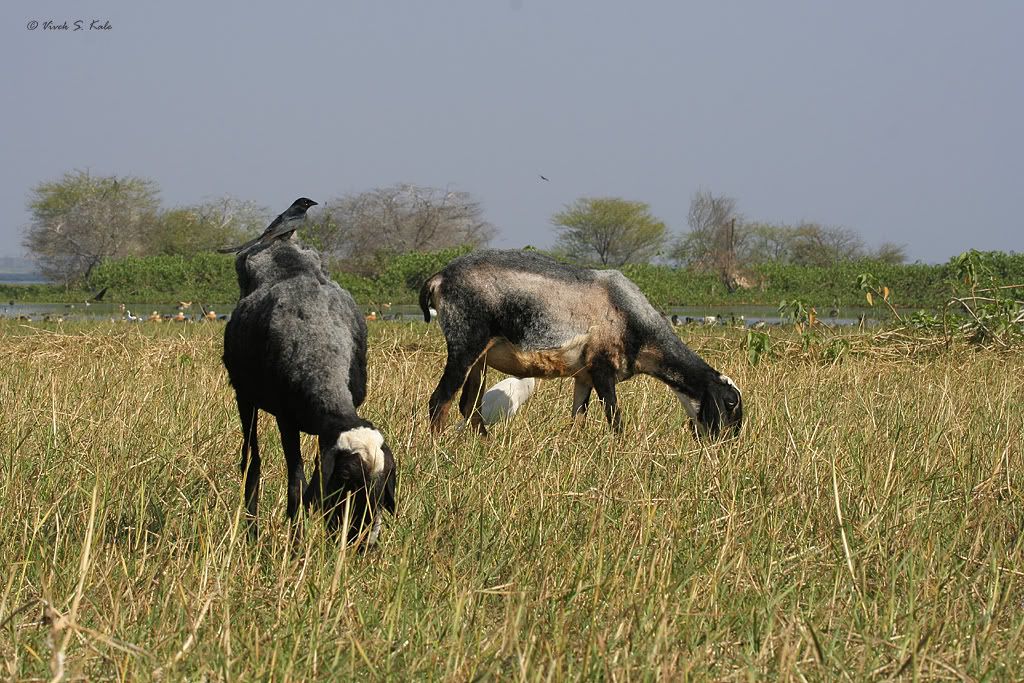 |
| Dicrurus macrocercus, Black Drongo, कोतवाल, Open Country, Maharashtra, Pune district
|
| Habitat : Open country
|
|
|
|
|
<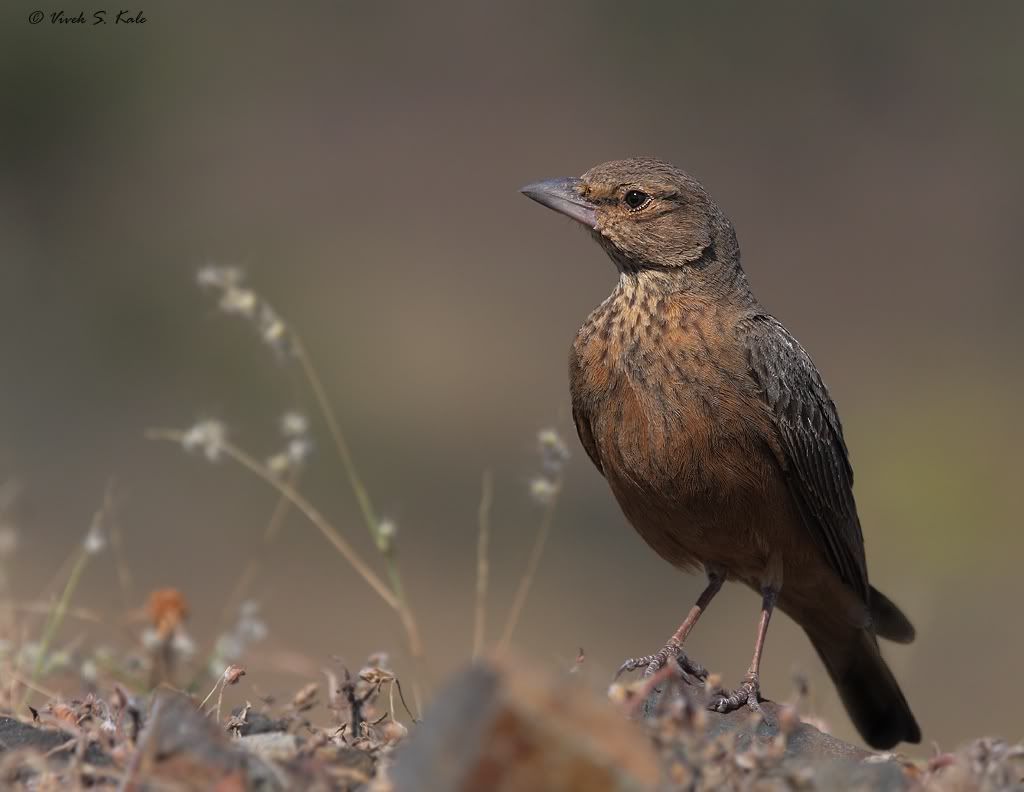 |
| |
|
Ammomanes phoenicura, Rufous tailed lark, मुरारी, dry arid region, grasslands, Pune district, India
|
| Habitat : dry arid region, grasslands
|
| |
|
|
माळरानावर शांत वातावरणात, कान देउन ऐकल्यास, कोण्या पक्ष्याचे गुणगुणणे ऐकु येते. अधुन मधुन ते वाऱ्याच्या तालावर डोलणाऱ्या गवताच्या सळसळीत हरवते. आवाजाचा माग घेतल्यास कोण्या दगडावर वा गवतात फिक्या तांबुस छटा असलेल्या करड़्या चिमणीपेक्ष्या मोठ़्या आकाराचा पक्षी आढळतो. चंडोल प्रकारात मोडणाऱ्या या पक्ष्याला, मुरारी असे त्याच्या गुणगुणत्या शीळ वाजवण्यामुळे संबोधतात. तांबुस करड्य़ा रंगाच्या या पक्ष्यास छातीकडे काळसर रेघा असतात. त्याची चोच गवताच्या बीया खाणाऱ्या सर्व पक्ष्यांसारखी असते. माळरानावरचा हा मुरारी जमिनीवरच घरटे करतो. |
|
Rufous-tailed Lark (Ammomanes phoenicura) is a bird seen in dry and arid region, grasslands. It whistles feeble notes and can be heard very easily. For its whistle, it is called as Murari in Marathi. Most of the plumage of this bird is rufous. It has streaks on its front. Wings are dark brown. It feeds on seeds from grass and crops.
(Call recording link by Vir Joshi - xeno-canto.org)
|
|
|
| |
<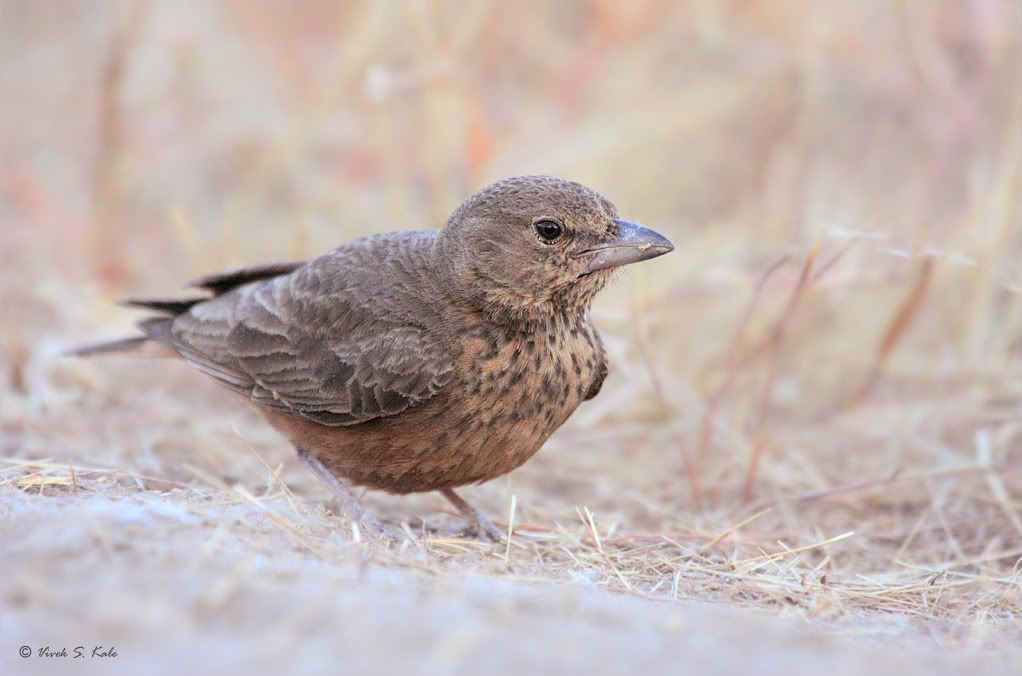 |
| |
|
Ammomanes phoenicura, Rufous tailed lark, मुरारी, dry arid region, grasslands, Pune district, India
|
| Habitat : dry arid region, grasslands
|
|
|
|
|
< |
| Vanellus malabaricus , Yelow wattled lapwing,पितमुखी टिटवी , open country, Maharashtra, Pune district
|
| Habitat : Open country
|
|
|
पिवळ्या रंगाची मांसल गाठण (वॅटल) असलेला हा पक्षी पितमुखी टिटवी असा ओळखला जातो. लालमुखी टिटवी पेक्षा आकाराने लहान असणारा हा पक्षी माळरानावर आढळतो. दोन चार च्या संख्येत आढळणाऱ्या या टिटवी, गवतावर झुकुन मान खाली करुन किडे खाताना माळरानावर दिसतात. दुपारच्या वेळेत बाभळीच्या सावलीत विसावतात. यांच्या डोळ्याच्या व चोचीच्या मध्ये पिवळी गाठण असते. त्याचा ते अलंकार म्हणुन वापर करतात. आपल्या जोडीदाराला आकर्षण म्हणुन त्याचा त्यांना वापर होत असावा. पोटाकडे सफेद असणारी टिटवी वरच्या भागात करड़्या राखाडी रंगाची असते. वरुन उडणाऱ्या शिकारी पक्ष्यांपासुन त्यामुळे त्याचे संरक्षण होते. त्याचा हा रंग आजुबाजुच्या माळरानात मिसळुन जातो. डोक्यावर काळा टोपीसमान भाग असतो. त्याचे पाय पिवळे असतात. मुळ स्वभाव लाल टिटवी सारखा असला तरी ह्याचे चित्त लाल टिटवीच्या तुलनेत शांत असते. इतर माळरानांवरच्या पक्ष्यांप्रमाणे तो त्याचे घरटे जमिनीवर करतो.
|
|
Yellow wattled Lapwing, Vanellus malabaricus is a bird seen in the arid region all across India, (25 cm). The bird is often seen in a group of 2-6 members, in dry grasslands on the ground, looking for insects. In the afternoon these birds are seen relaxing in shadows under the trees. As the name suggests, the bird has yellow wattle between its eyes and bill. The wattle is an ornamental organ. It is mainly useful as an ornament for courting mates. Larger wattle indicates good health, nutrition and ability to survive. Many other birds such as red headed vulture, red Jungle fowl, red wattled lapwings etc. also have similar organ called as wattle. Yellow wattled lapwings have sandy grey upperparts with white underbody and black crown. As compared to red wattled lapwing the yellow wattled lapwings are less noisy and smaller in size. The various colors of the iris of this bird have been recorded. The colors recorded are pale yellow, silver grey and brown. Interestingly the iris of the bird in the image here is dual, silver grey at the top and brown in the lower portion of iris. The eyes are surrounded by a thin yellow circle. The consistency of the black color on the crown is disturbed by small sandy grey patches. The white patch behind both the eyes meet at the backside. The bird is known as Pitamukhi Titvi in Marathi.
(Call recording link by David Farrow - xeno-canto.org)
|
|
|
|
|
<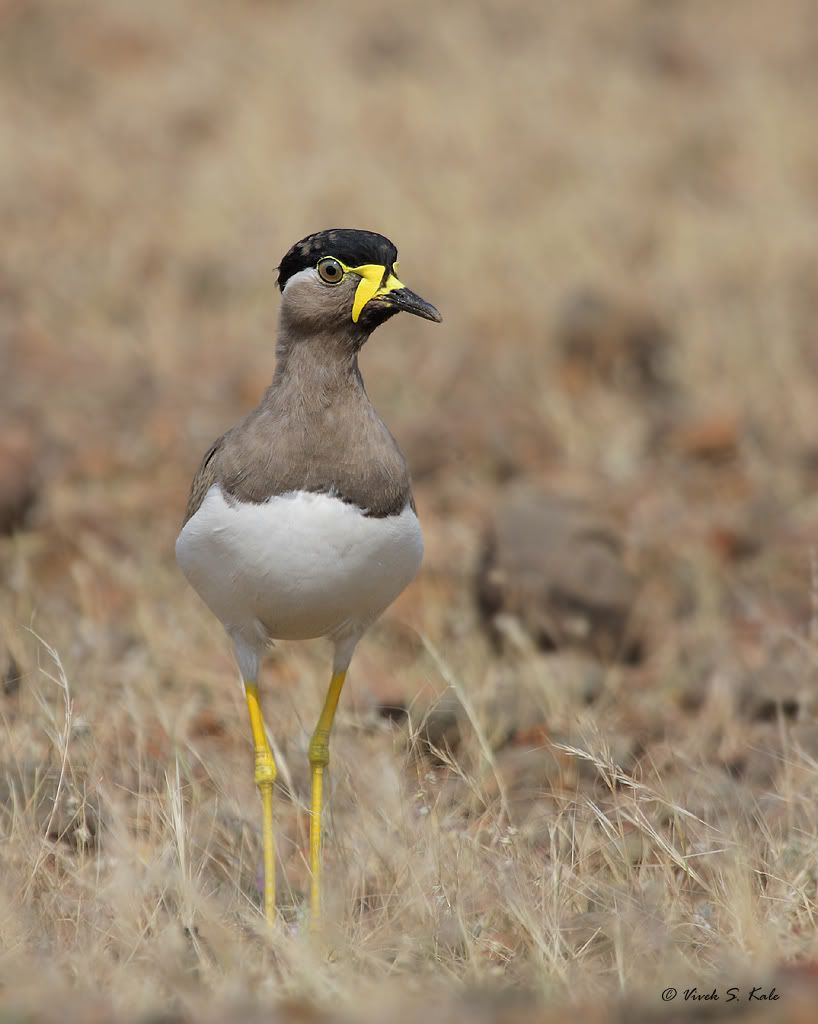 |
| Vanellus malabaricus , Yelow wattled lapwing,पितमुखी टिटवी , open country, Maharashtra, Pune district
|
| Habitat : open country
|
|
|
|
|
< |
| Booted Eagle, Hieraaetus pennatus, Dry country, Maharashtra, Pune district |
| Habitat : Dry country
|
|
|
बुटेड ईगल हा एक स्थलांतर करणारा लहान आकाराचा गरुड पक्षी आहे. आपल्याकडे तो हिवाळ्यात शुष्क भागात व डोंगराळ भागात दिसतो. गडद व फिका अशा त्याच्या दोन वेगळ्या रंगभुषा असतात. चित्रातील गरुड हा फिक्या अवतारात आहे. तांबुस चॉकलेटी रंगाचे त्याचे डोळे भेदक वाटतात. पायावर त्याला पिसे असतात. उन्हाळ्यात तो मध्य आशिया व युरोपात असतो तर हिवाळ्यात तो दक्षिण आशियात शरण घेतो. स्टेपी इगल (७५ से मी) च्या मानाने तो लहान असतो (४७ से मी). लहान पक्षी, छोटी जनावरे तो शिताफी ने पकडुन खातो. चित्रात त्याने एका पितमुखी टिटवी ला पकडले आहे असे दिसते. |
|
Booted eagle – (Hieraaetus pennatus) is a medium sized (47 cm in length) bird. It is the smallest in size among the eagles seen in India. Its wingspan is about 120 cm. The eagles such as Tawny eagles are about 75 cm in length. So it is about 2/3rd of size of Tawny eagle. The booted eagle is seen in 2 phases, dark and pale. The bird shown in image here is in pale phase. It is a migratory bird. It breeds in Eurpoe and North Asia. In winter it is seen in South Asia and Saharan Africa. It is seen in dry open country with hilly terrain. Pale birds are mainly light grey with a darker head and flight feathers. The other form has mid-brown plumage with dark grey flight feathers. The key identification features of this bird are its small size (47 cm), Its forehead and lores are buff white with black streaks around and in the middle of the eyes. It has dark centered feathers. The eagle has feathered tarsus. Its eye iris is brown. Its scientific name is Hieraetus pennatus. as per IOC list. Some European organisations name it as Aquila pennata. The bird is known to be an expert killer of small/medium sized birds (mid air, on ground) and small mammals.
|
|
|
|
|
<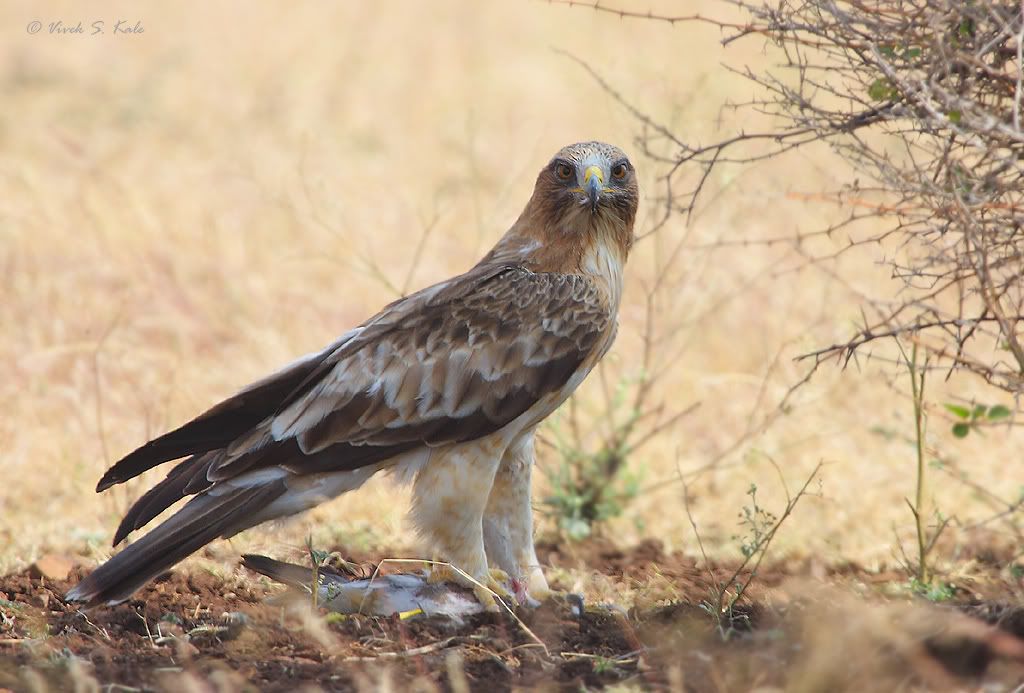 |
| Booted Eagle, Hieraaetus pennatus, Dry country, Maharashtra, Pune district
|
| Habitat : Dry country
|
|
|
|
|
< |
| Spot billed duck, Anas poecilorhyncha, small fresh water ponds and lakes, Jamnagar, Gujrat, India.
|
| Habitat : small fresh water ponds and lakes |
|
|
मध्यम आकाराचे राखी बदक लहान तळयात हमखास दिसते. एका ठिकाणी त्यांच्या २-४ जोड्या दिसतात. संख्येने ते एका ठिकाणी खुप नसतात. त्याच्या चोचीवर टोकाकडे पिवळा रंग व चोचीच्या बुडाशी दोन्हीकडे तांबुस डाग दिसतो. त्याचे पाय नारंगी असतात. जलवनस्पती, शेतातील बी हे त्यांचे खाद्य होय. मादी पक्ष्यात चोचीच्या बुडाकडील तांबुस डाग लहान असतात.
|
|
Spot billed ducks are grey in color.
Its beak colors make it more interesting.
Its bill is black in color tipped bright yellow..
At the base of the bill, one can see a red spot. In male birds the red spot is predominant as compared to female birds.
Anas poecilorhyncha is its scientific name.
At Lakhota lake the birds were seen habitual to eat the food offered by the citizens of Jamnagar. The birds were seen eating pop corns, glucose biscuits, etc. In wild they eat plant food.
(Call recording link by Mathias Ritschard, xeno-canto.org)
|
|
|
|
|
<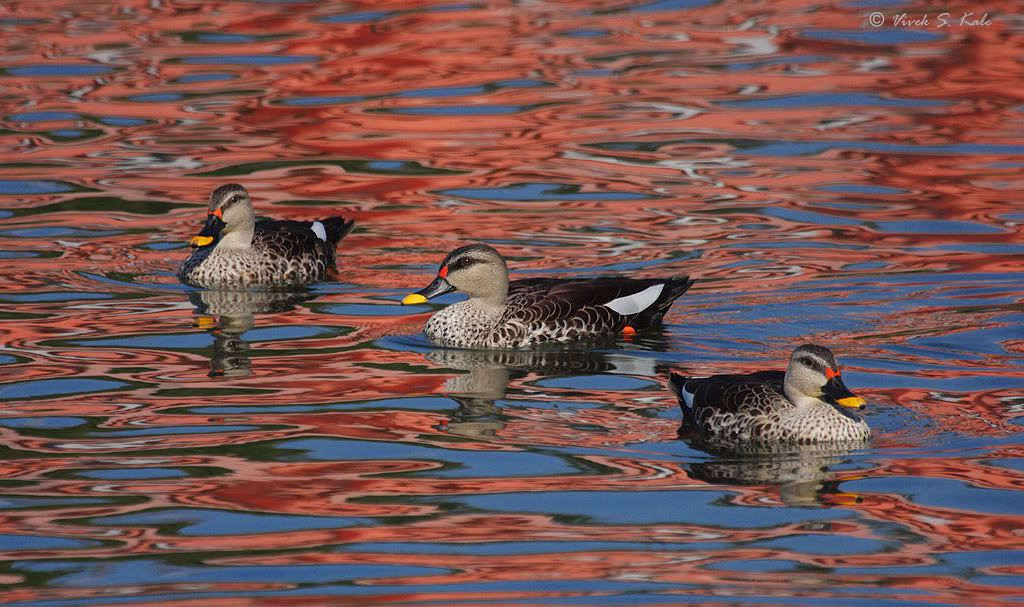 |
| Spot billed duck, Anas poecilorhyncha, small fresh water ponds and lakes, Jamnagar, Gujrat, India.
|
| Habitat : small fresh water ponds and lakes
|
|
|
|
|
<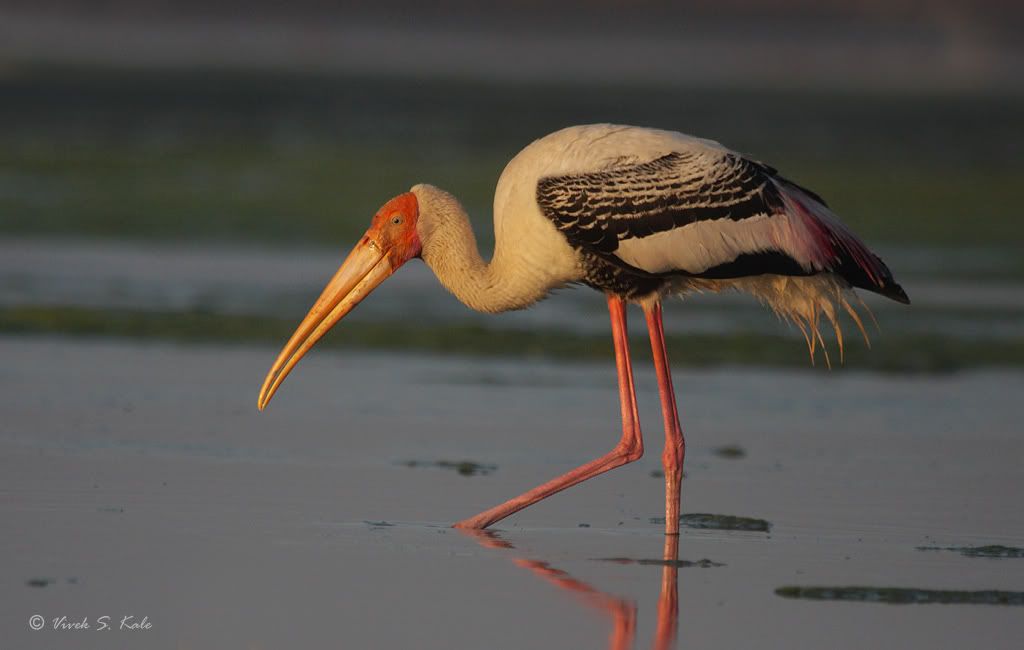 |
| Painted Stork, Mycteria leucocephala, रंगीत करकोचा , wetland, , Pune district, Maharashtra, India.
|
| Habitat : rivers, wetlands
|
|
|
रंगीत करकोचा हा अंदाजे १ मीटर उंचीचा रंगाने पांढरा, पाणथळ ठिकाणी दिसणारा पक्षी होय. त्याच्या अंगावर शेपटाकडे असणाऱ्या गुलाबी पिसांमुळे त्याला रंगीत करकोचा असे म्हणतात. त्याच्या लांब चोचीचा रंग पिवळसर असतो. सकाळच्या वेळेत तो उथळ पाण्यात, मासे पकडण्यात रमतो. एका पायाने पाणी ढवळत, दुसऱ्या पायावर तोल सांभाळत तो मासे व लहान किडे पकडतो. वेळ प्रसंगी तो पंख पसरुन त्याचा तोल सांभाळतो. दुपारच्या तापलेल्या उन्हात उंच आकाशी तो गरम हवेच्या झोतावर उडताना दिसतो. या पक्ष्यांचा अधिवास लोप पावत असल्याने, ते "निअर थ्रेटंड" झाले आहेत. हि त्यांना माणसाने दिलेली दुर्दैवी उपाधी होय.
|
|
Painted Stork is a large stork. It is white colored, with tertial tipped with pink. It has black band on breast. It has large yellow bill. The birds are often seen in shallow waters. They use their legs to disturb the water. Balancing over one leg they keep moving through shallow waters in search of small fish and aquatic insects. These birds are resident. Mainly seen in India and Eastern China. These birds next on the trees. The birds are classified as near threatened due to disturbance to its habitats. (Call recording link by David Farrow, xeno-canto.org)
|
|
|
|
|
<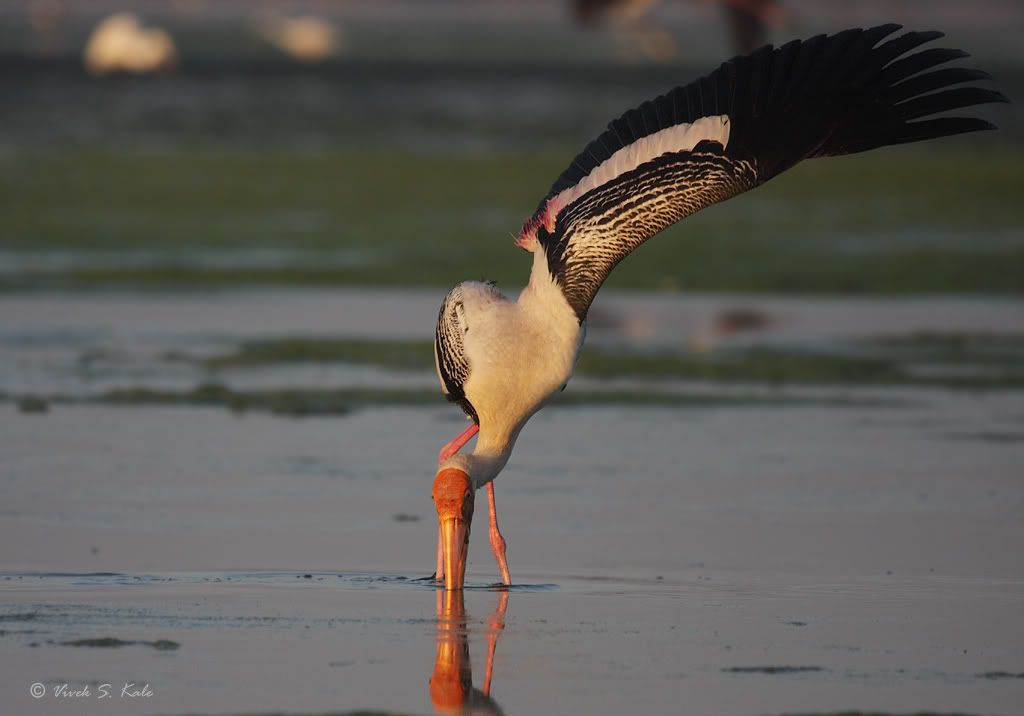 |
| Painted Stork, Mycteria leucocephala, रंगीत करकोचा , wetland, Pune district, Maharashtra,India.
|
| Habitat : rivers and wetlands
|
|
|
|
|
<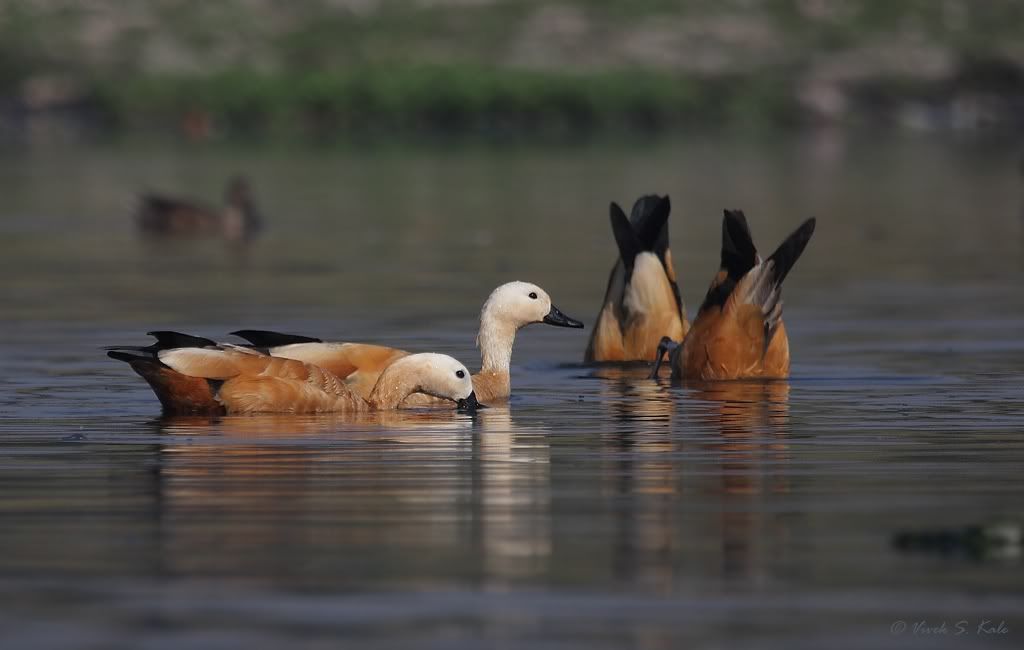 |
| Rudy Shelduck, Tadorna ferruginea,चक्रवाक,around the wetlands, December, Pune district, Maharashtra, India
|
| Habitat : wetlands
|
|
|
रुडी शेलडक किंवा ब्राह्मिणी डक अशा नावांनी ओळखल्या जाणाऱ्या या तपकिरी भगव्या रंगाच्या बदकांचा वावर हिवाळ्यात सर्व पाणथळ ठिकाणी असतो. हिमालयाच्या उत्तरेकडुन हे पक्षि दक्षिण भारताकडे दर हिवाळ्यात स्थलांतर करतात. नर पक्ष्याला मानेकडे काळी पट्टी असते. मात्र हि पट्टी हिवाळ्यात गायब झालेली दिसते. मराठीत या बदकाला चक्रवाक असे म्हणतात. पाण्यात डुबकी मारुन (डोके खाली, शेपुट वर) हे पक्षी उथळ पाण्यातील पाणवनस्पती, शंख, शिंपले खातात.
|
|
The rudy shelducks or Brahminy ducks are winter visitors to South Asia. These birds breed in Central Asia in summer. During the breeding season, the male birds can be identified by a black collar around its neck. The birds are often seen on the river banks in pairs. When disturbed they honk loudly. The face of the bird is whitish, the body is orange brown colored.
(call recording by Stuart Fischer, xeno-canto.org)
|
|
|
|
|
<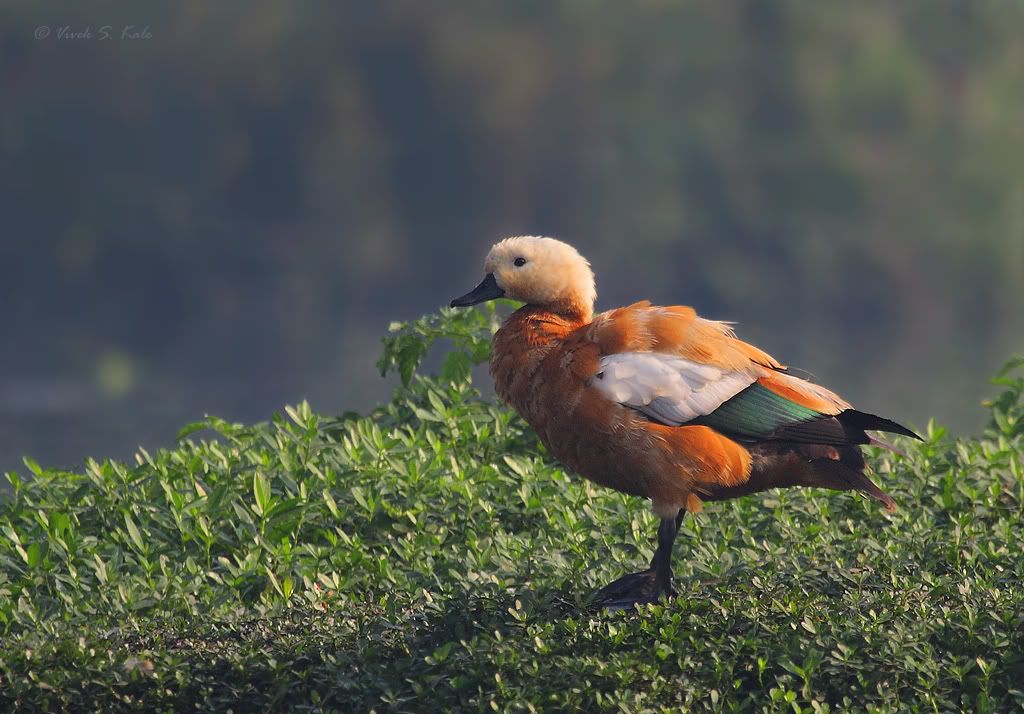 |
| Rudy Shelduck, Tadorna ferruginea,चक्रवाक,around the wetlands, December, Pune district, Maharashtra, India
|
| Habitat : wetlands
|
|
|
|
|
<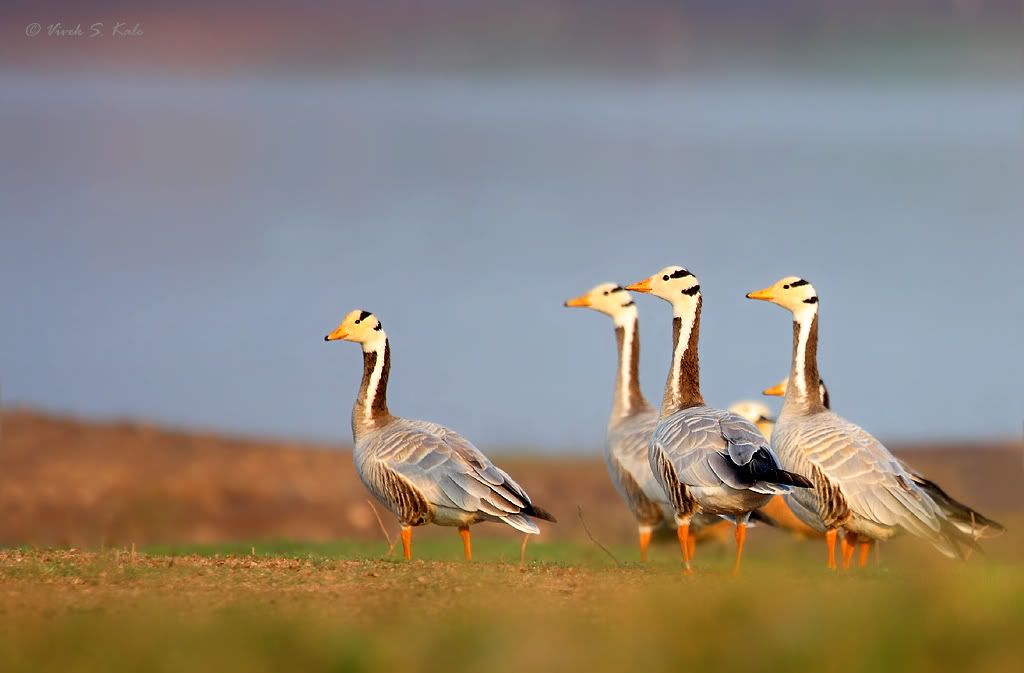 |
| Bar-headed goose,पट्ट कदंब,Anser indicus, wetlands with grazing fields, Maharashtra, Pune district, India
|
| Habitat : wetlands with grazing fields
|
|
|
बार हेडेड गूज उर्फ़ पट्ट कदंब हे बदक मध्य आशियातील (रशिया, मंगोलिया, तिबेट व लडाख) सरोवरांच्या भागात उन्हाळ्यात रहाते. तेथे हे पक्षी, आपली घरटी करतात. हिवाळ्यात मात्र ते तेथील थंड हवामानापासुन बचाव करण्यासाठी हिमालय ओलांडुन भारतात स्थलांतर करतात. हिवाळ्याअखेर ते परत मध्य आशियात जातात. परतीच्या प्रवासात समुद्र्सपाटीवरुन हिमालयाच्या रांगा ओलांडत तब्बल ७००० मीटर उंचीवरुन उडत जाणे असा खडतर प्रवास करावा लागतो. वजनाच्या मानाने मोठे पंख, कमी दाबाच्या व कमी प्राणवायु असलेल्या थंड वातावरणातुन जाणारा पक्षी असल्याने तो एक महत्वाचा अभ्यासाचा विषय झाला आहे. जगातला सर्वात उंचावरुन उडणारा पक्षी म्हणुन तो ओळखला जातो. इतर स्थलांतर करणाऱ्या पाण पक्ष्यांविपरित तो स्वच्छ पाण्याच्या तळ्यांभोवती आढळतो. उथळ पाणी व पाण्याजवळची हिरवी शेते व कुरणे हा त्याचा हिवाळ्यातला आपल्याकडील अधिवास होय. हिवाळ्यात हे पक्षी गटगटाने दिसतात. चक्रवाकापेक्षा मोठ्या आकाराच्या या सफेद करड़्या रंगाच्या बदकाच्या डोक्यामागील भागावर डोळ्यामागे व मानेकडे दोन काळ्या ठळक रेघा असतात. त्याचा चेहरा सफेद, तर चोच व पाय पिवळसर भगवे असतात.
|
|
Bar headed Goose, (Anser indicus) is a bird known for its extraordinary migration. These birds breed in summer around high altitude lakes in Ladakh ,Tibet, Mangolia and other parts of Central asia. Birds migrate in summer to low land north, central and south India, in late October. In summer, in mid February, march it returnes to high altitude region across Himalayas for its breeding. It is said to one of the fastest uphill migration, to the region with low oxygen level. It is the only bird ever seen above 8000 meter altitude in air. The Bar-headed Goose is thought to be one of the world's highest flying birdsThe bird has larger wing area to weight ratio. It also performs well in low oxygen levels. Birds seen around Pune region seems to prefer a cleaner shallow water lakes with moist surroundings having fields/farms to graze up on over sewaged backwater in drier regions.
The tags of the birds indicate that the birds tagged in Mangolia have been reported in Pune/Satara region every winter. They reach India from Mongolia in just two to three days.
The bird is pale grey, white colored with bar marks on its head. The color of its beak and legs is yellow.
(Call recording by Sander Bot- xento-canto.org)
|
|
|
|
|
<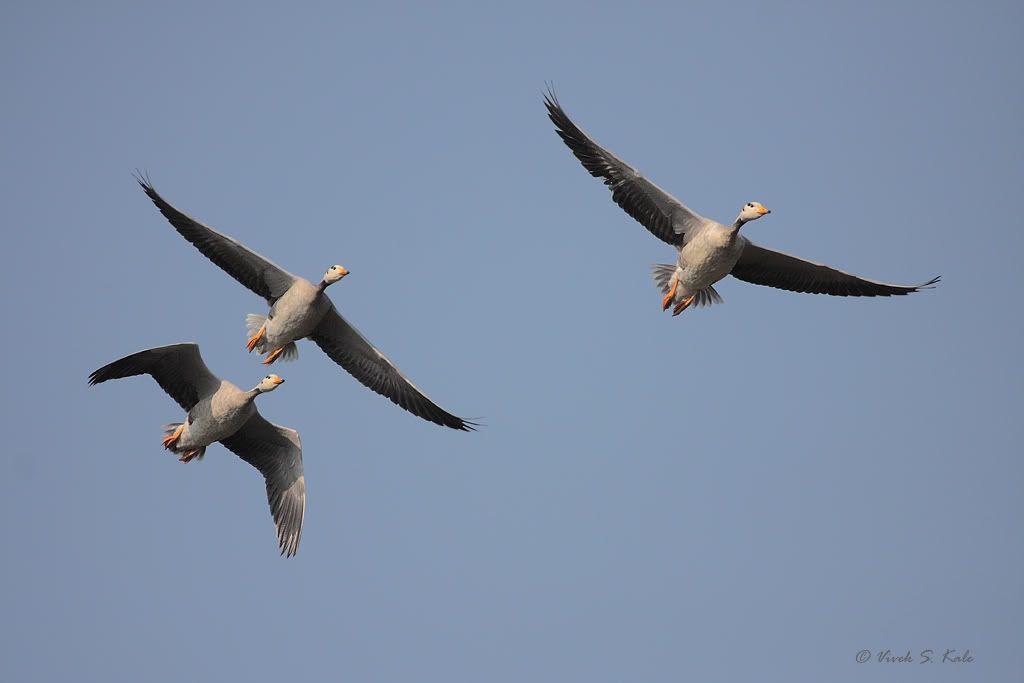 |
| Bar-headed goose,पट्ट कदंब,Anser indicus, wetlands with grazing fields, Maharashtra, Pune district, India
|
| Habitat : open country grassland
|
|
|
|
|
<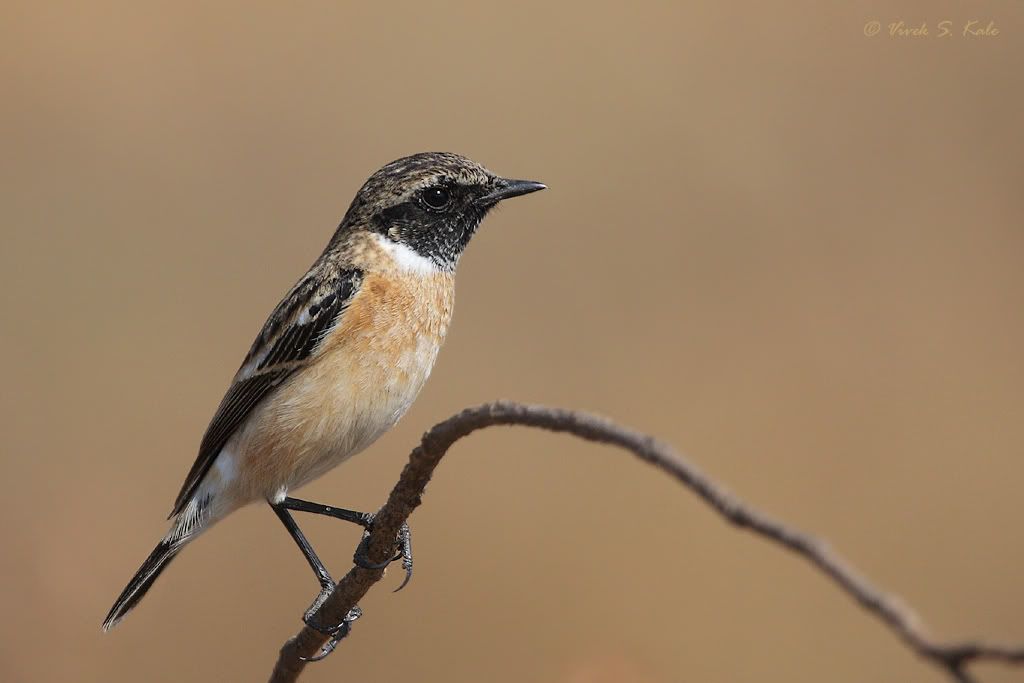 |
| Common Stonechat, Saxicola maurus, गळोटीवाला गप्पीदास Open country, Maharashtra, Pune district, India
|
| Habitat : scrub land
|
|
|
कॉमन स्टोनचॅट किंवा सायबेरिअन स्टोनचॅट नावाचा हा पक्षि ओसाड भागात आढळतो. पोटाकडे फिक्या नारंगी रंगाचा नर डोक्यावरच्या काळ्या रंगामुळे सहज ओळखला जातो. चिमणीपेक्षा लहान आकाराचा हा पक्षी झुडुपाच्या व लहान वनस्पतींच्या तुऱ्यावर बसलेला दिसतो.गळोटीवाला गप्पीदास ह पक्षी हिवाळ्यात गवताळ प्रदेशात सापडतो. त्या काळात तो मध्य आशिया, सैबेरिया या भागात दिसतो. मानेकडे त्याला सफेद पट्टे असतात. मादी मात्र काळ्या डोक्याची नसते. तिच्या वरच्या अंगावरच्या रेघा गडद असतात.
|
|
The male bird is black headed and a patch of of orange on the throat.
The female has pale brown upperparts and head, white neck patches, and a pale, unstreaked pinkish-yellow rump. Males in winter plumage are intermediate between summer males and females,
Its scientific name means "dark rock-dweller". Saxicola means "rock", incola means "inhabitant"; maurus means "black"
It breeds in summer in Central and North Asia, Siberia. In winter it is seen in South Asia, Thailand and North Africa.
The bird is known as common stonechat or Siberian stonechat.
|
|
|
|
|
<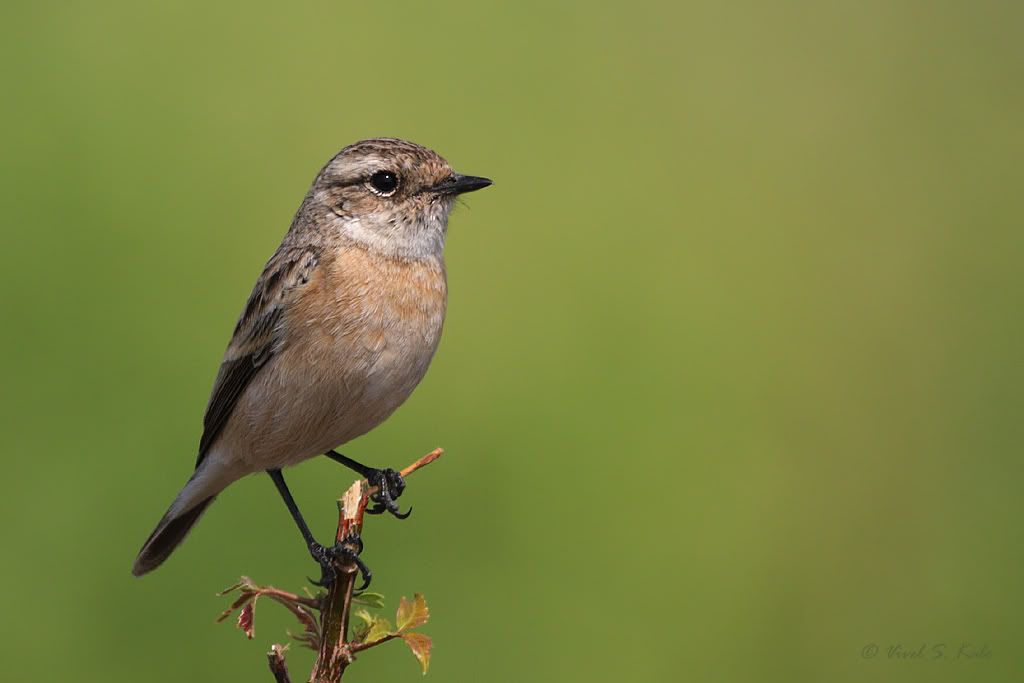 |
| Common Stonechat, Saxicola maurus, गळोटीवाला गप्पीदास Open country, Maharashtra, Pune district, India
|
| Habitat : scrubland
|
|
|
|
|
<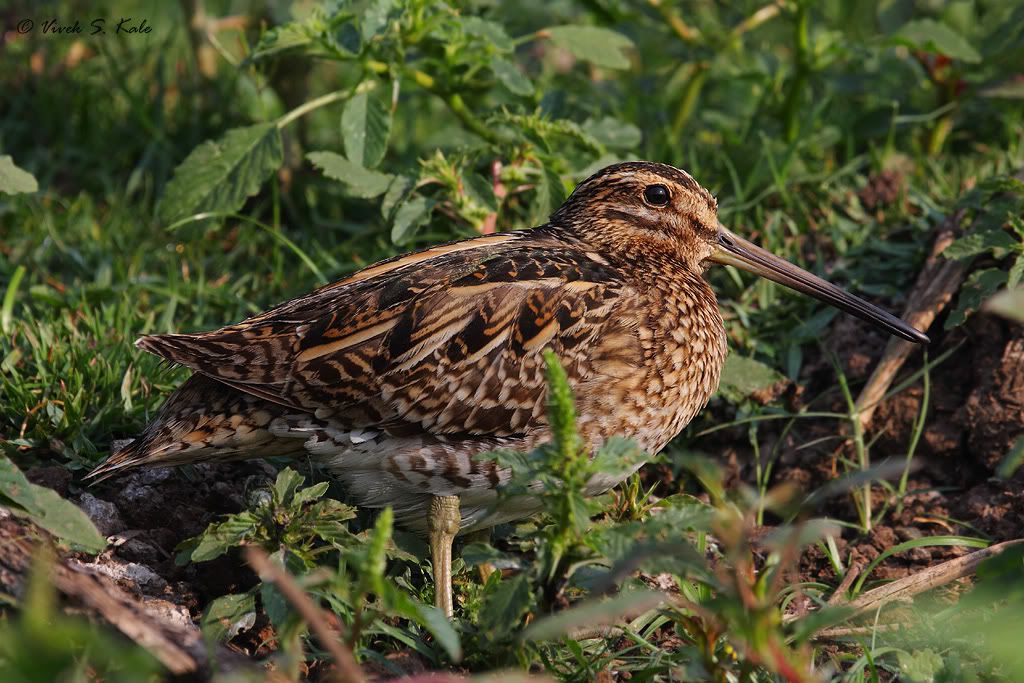 |
| Common snipe, Gallinago gallinago, wetlands, swamps, Maharashtra, Pune district, India
|
| Habitat : wetlands, swamps
|
|
|
स्नाइप नावाचा लहान आकाराचा पक्षी पाणथळ ठिकाणी आढळतो. त्याच्या वाकड़्या तिकड़्या व झटकन उडण्यामुळे तो लगेच ओळखु येतो. लांब चोचीचा वापर करत तो गवतात किडे शोधत फिरताना दिसतो. दुपारच्या वेळेला तो निवांत बसतो. त्याच्या अंगावरच्या रंगसंगतीमुळे तो दुरुन पटकन दिसत नाही.
|
|
The common snipe is dark brown in color.
It has a rapid twisting flight. The birds are seen in swamps looking for worms, snails, fish and other aquatic insects. As this bird was used for shooting game in the past, the work sniper has been derived from it meaning sharp shooter. The bird is often confused with other snipes, such as jack snipe, pintail snipe. The common snipe has longer bill with respect to other species. There are also other differences in the white/brown patches on its face, tail details, shape of head etc.
(call recrding link by Stuart Fischer, xeno-canto.org)
|
|
|
|
|
<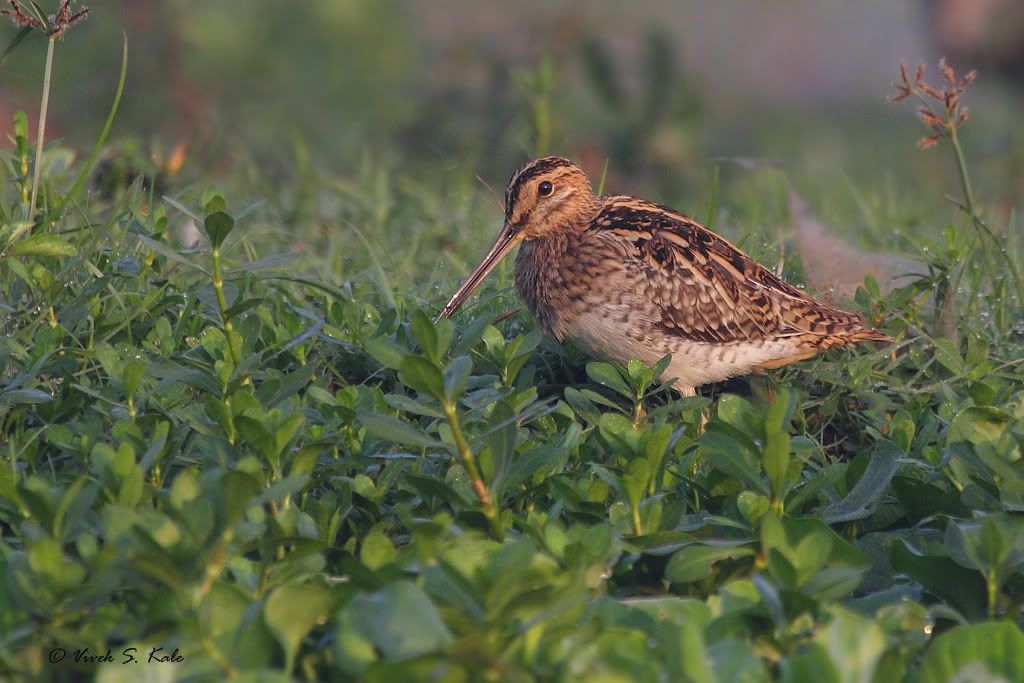 |
| Common snipe, Gallinago gallinago, wetlands, swamps, Maharashtra, Pune district, India
|
| Habitat :wetlands, swamps
|
|
|
|
|
< |
| Black kite juvenile, घार ,Milvus migrans, around wetland, Maharashtra, Pune district, India
|
| Habitat : urban region, waste dumps, around wetlands
|
|
|
काळी घार हा आपल्याकडे सर्रास दिसणारा शिकारी पक्षी आहे. शहरात कचऱ्याच्या ठिकाणी, व इतरत्र तो हमखास दिसतो. आकाशात गरम हवेच्या झोत्यात घिरट्या घालत उडताना दिसतो. भारतात या पक्ष्यांची संख्या खुप आहे. चित्रातील पक्षी हा वयाने लहान घार आहे. त्याच्या पोटाकडे व छातीकडे तपकिरी रेघा आहेत.
|
|
The Black Kite, Milvus migrans is an opeertunist bird of prey. It is often seen thriving in the urban areas, where the rodents, scavenging opertunities are available. The birds spend lot of time gliding in the thermals in the search of its food. The birds are in abundance in South Asia. Though this bird migrates in some parts of the world, in India these birds are mostly resident.
|
|
|
|
|
<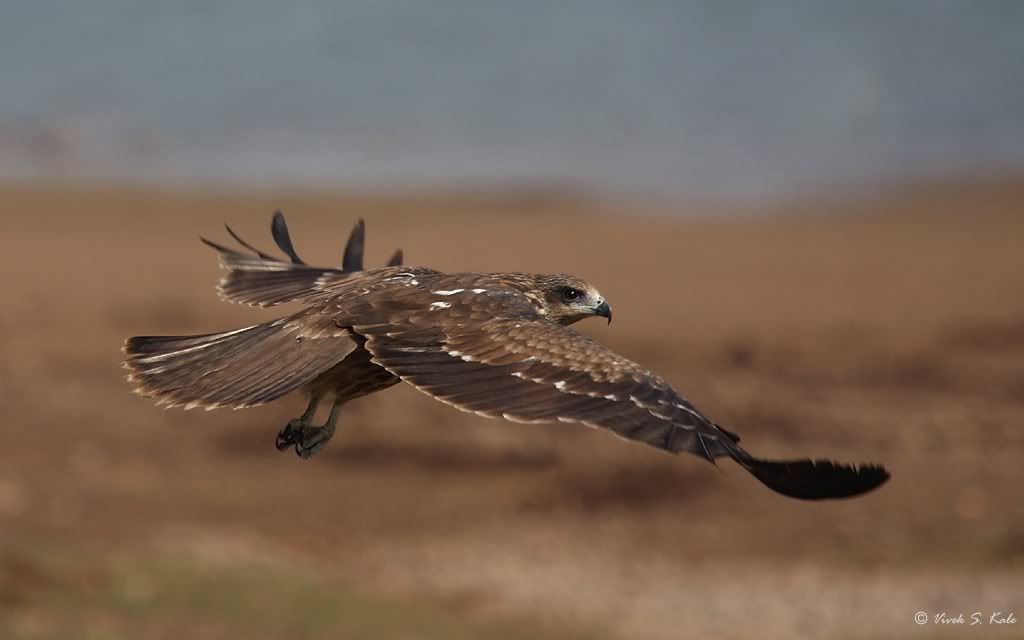 |
| Black kite juvenile, घार ,Milvus migrans, around wetland, Maharashtra, Pune district, India
|
| Habitat : urban region, waste dumps, around wetlands
|
|
|
|
|
<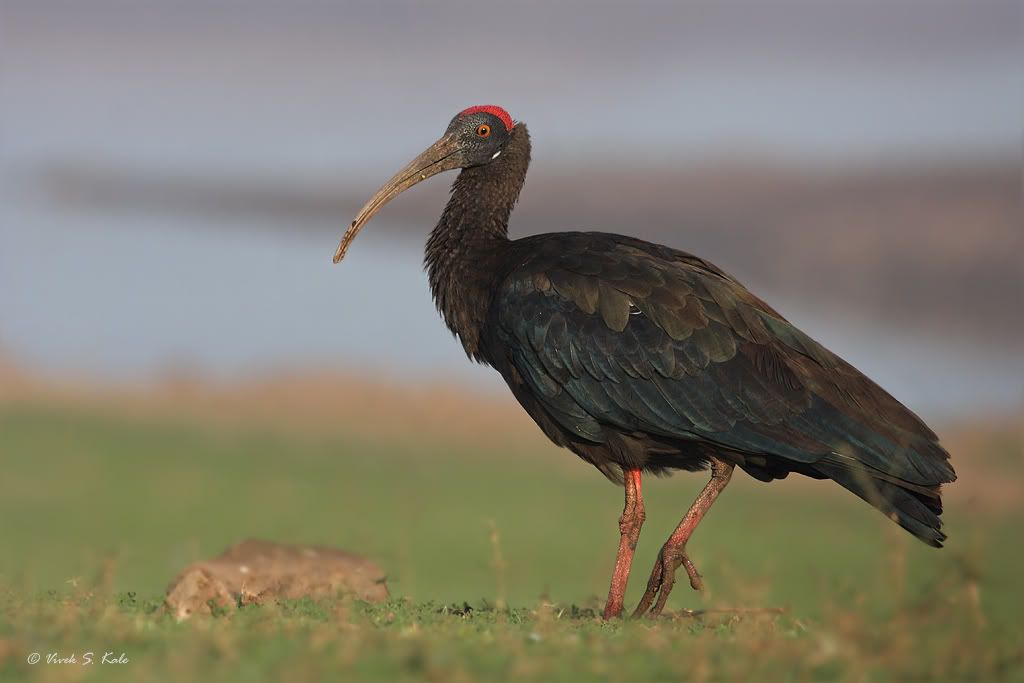 |
| Red-naped Ibis, Pseudibis papillosas, margins around wetland cultivated fields, लाल टोपीवाला शराटी, Maharashtra, Pune district, India
|
| Habitat : margins around wetland cultivated fields
|
|
|
काळा शराटी किंवा लाल टोपीवाला शराटी हा मोठय़ा आकाराचा पक्षि गवताळ जमिनीवर, शेतात किडे
शोधत फिरताना दिसतो. काळसर रंगाच्या या पक्ष्याचे पाय लालसर रंगाचे असतात. डोक्यावर लाल किरमिजी रंगाचा त्रिकोणी चामखिळवजा तुरा असतो. पांढ्ऱ्या शराट्यासारखा हा पाण्याजवळ/पाण्यात नसतो. रात्रीच्या वेळेला हे पक्षि झाडावर विसावतात. घरटी ते झाडावर करतात. रंगाने हा काळा असला तरी, त्याच्या पंखांवर निळसर चकाकी असते. वयाने लहान पक्ष्यांच्या डोक्यावर लाल भागाऐवजी तपकिरि रंगाची लहान पिसे असतात.
|
|
Red-naped Ibis, Pseudibis papillosa is large bird seen all cross Indian planes. Its habitat is mainly the dry cultivated land / and open land around wetlands where it finds lots of insects. Unlike its other sister species like white ibis, this bird is not found inside the wetland/marsh. It rarely wades or feeds on fish. It is always seen grazing in the grass, dry cultivated land looking for insects.
The neck, mantle, lower back, rump and lower plumage is
Brown. The back is bronze-green glossy colored and the tail is
black, richly glossed with blue-green.
There is a conspicuous white patch on the inner lesser wing-coverts.
The rest of wing is black, glossed richly with deep blue or purple-blue.
The eye iris is dull to bright orange-red. The bill is dull green. The head has naked black colored skin with a triangular portion
of brilliant red papillae (warts)covering the skin from a point above the forehead to the back of the nape. The juvenile bird do not have red warts on its head. Instead the young birds have non glossy brown feathers on their head. Its legs and
feet are thick and are brick-red colored.
Though the bird is very silent sometimes it makes a grunting call.
|
|
|
|
|
<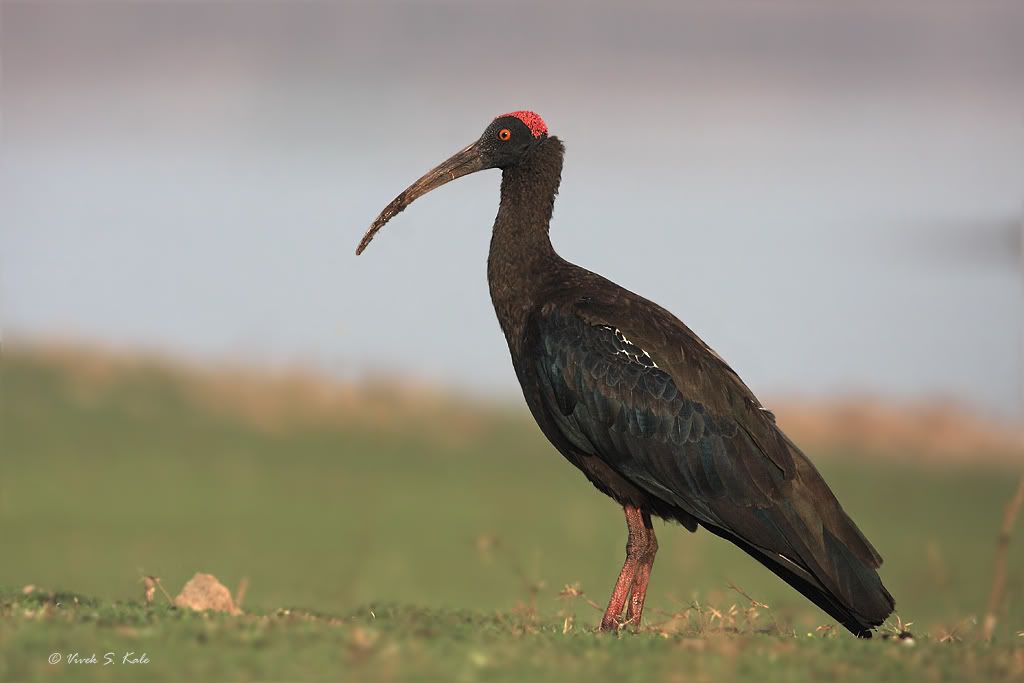 |
| Red-naped Ibis, Pseudibis papillosas, लाल टोपीवाला शराटी, margins around wetland cultivated fields, Maharashtra, Pune district, India
|
| Habitat : margins around wetland cultivated fields
|
|
|
|
|
<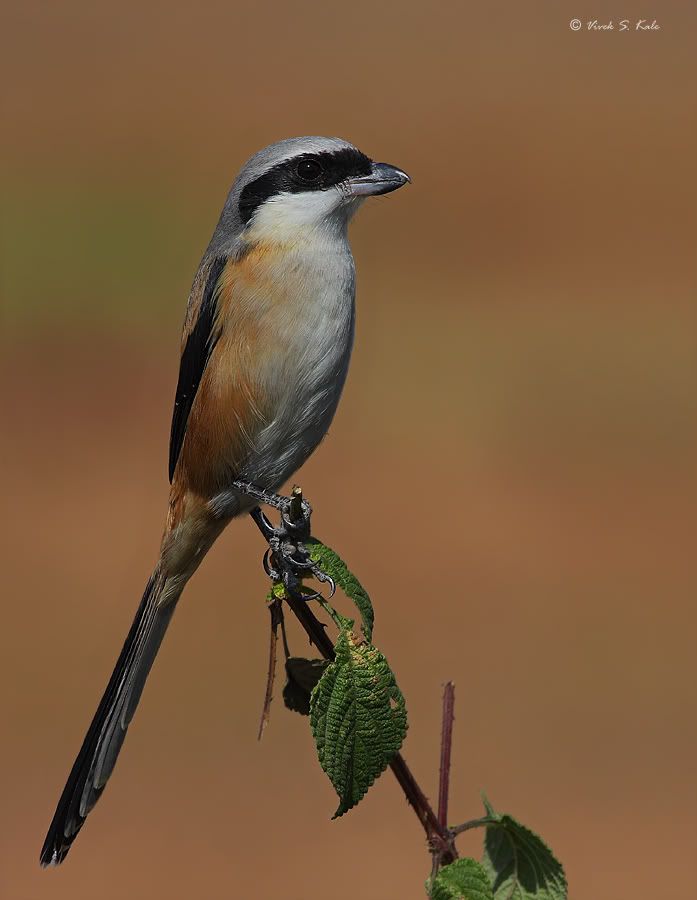 |
| Long tailed shrike, खाटीक, Habitat : dry region, around cultivation, Maharashtra, Pune district, India
|
| Habitat : dry region, around cultivation
|
|
|
|
|
<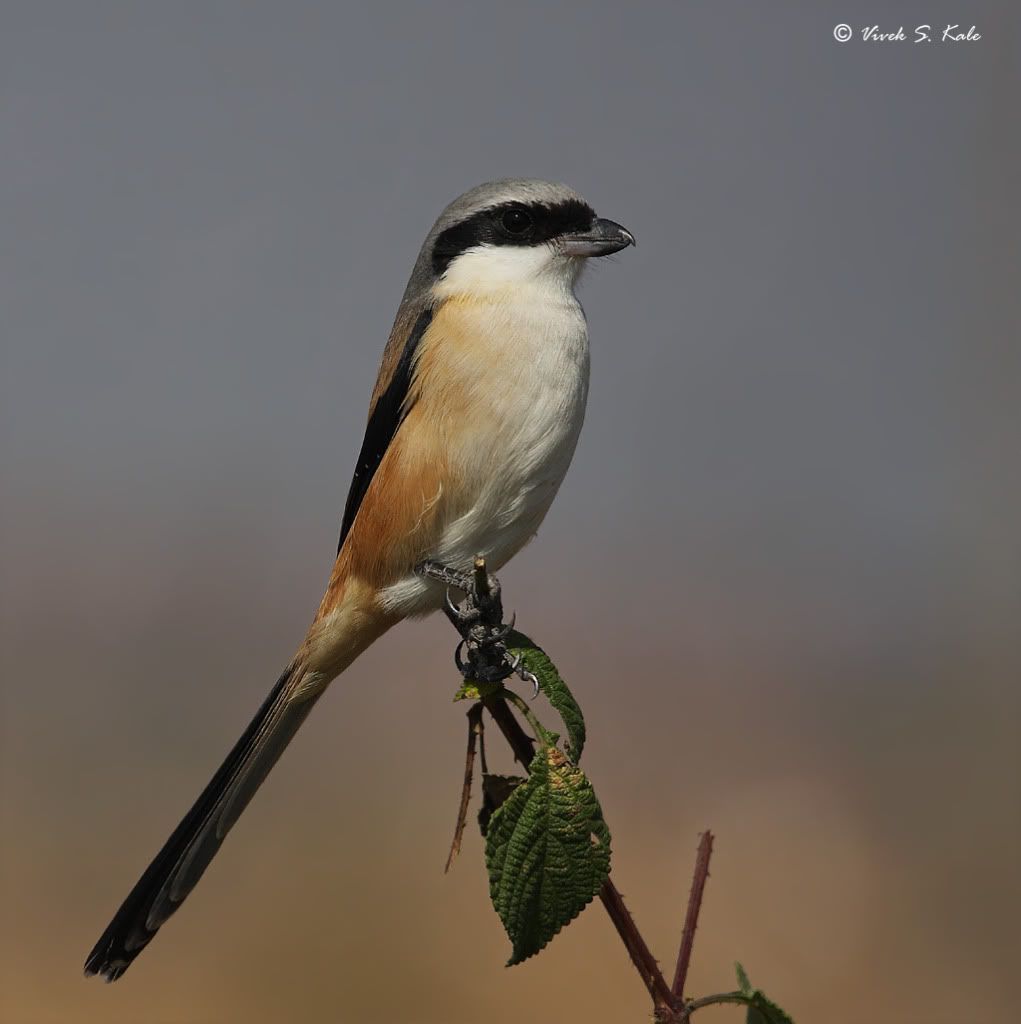 |
| Long tailed shrike, खाटीक, Habitat : dry region, around cultivation, Maharashtra, Pune district, India
|
| Habitat :dry region, around cultivation
|
|
|
The long tailed shrike is also known as rufous backed shrike. It s crown is grey. it has a black mask over its eye from beak to ear coverts. Its front body is white with rufous on its sides. Its tail is black with rufous edges. It uses acasia thorns to struck the kills. Then it tears the kill using its bill holding the kill on the thorns. It uses this method as it can not use its feet to hold the kill, like raptors do.
(call recording by mike nelson- xeno-canto.org)
|
|
लांब शेपूट्या खाटीक हा गावाबाहेर एखाद्या बाभळीवर बसलेला हमखास दिसतो. तो त्याची तीक्ष्ण नजर आजुबाजुस काही भक्ष्य शोधण्यासाठी वापरतो. लहान किडे, भुंगे, उंदिर, सरडे व वेळप्रसंगी लहान पक्षी हे त्याचे खाद्य होय. बाभळीच्या काट्यांचा वापर करत तो भक्ष्याची चिरफाड करतो. म्हणुनच त्याला खाटिक असे म्हणतात.
|
|
|
|
|
<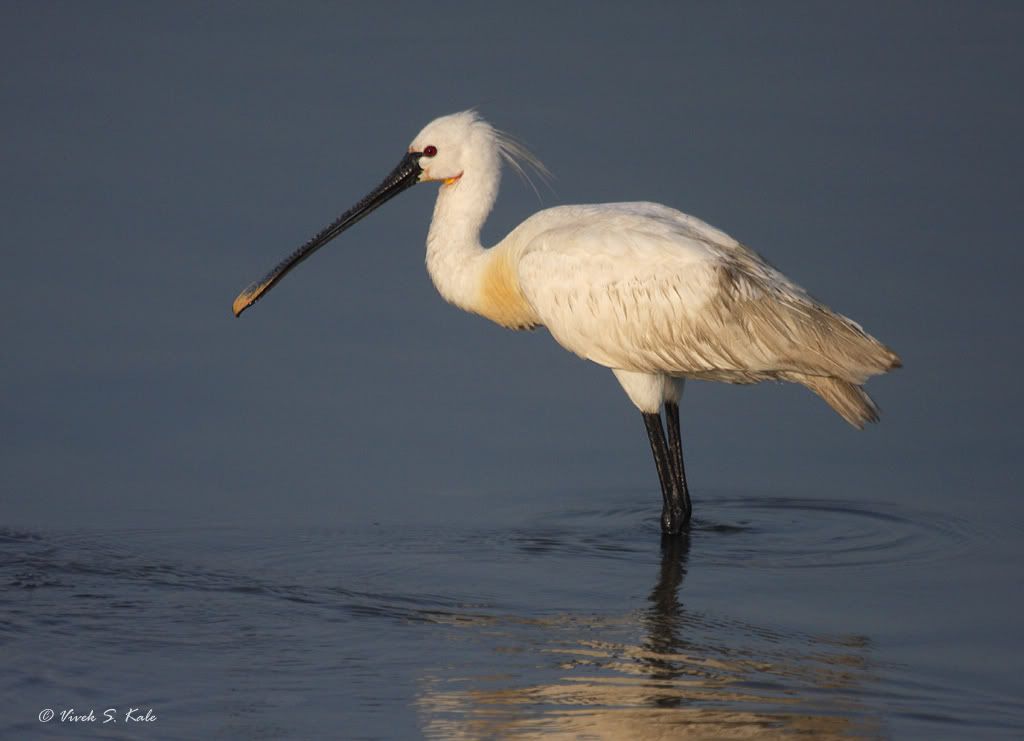 |
| Eurasian spoonbill, चमचा, Habitat : wetland, Maharashtra, Pune district, India
|
| Habitat : Wetland
|
|
|
|
|
<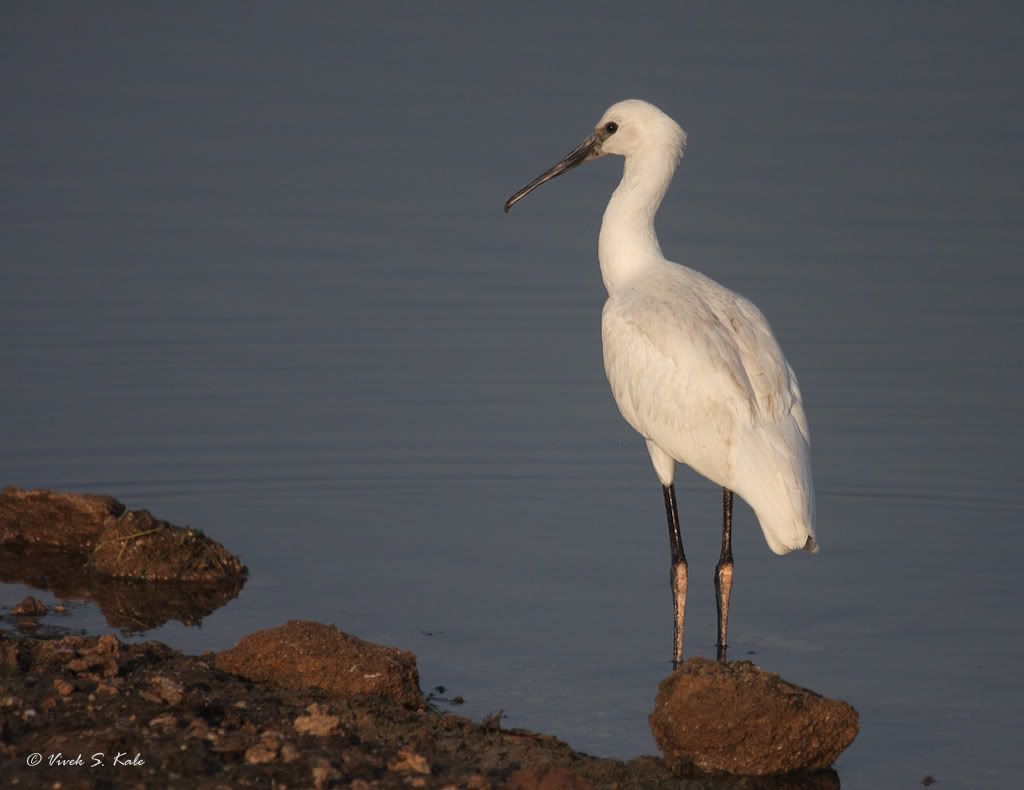 |
| Eurasian spoonbill, चमचा, Habitat : wetland, Maharashtra, Pune district, India
|
| Habitat :Wetland
|
|
|
चमचा म्हणजे युरेशियन स्पुनबिल, हा स्थलांतर करणारा पक्षी आपल्याकडे हिवाळ्यात दिसतो. उन्हाळ्यात तो उत्तरेकडे युरोपात असतो. सफेद रंगाच्या या पक्ष्याची खासियत म्हणजे त्याची चमच्या सारखी चोच. त्याचा वापर तो पाणी ढवळुन मासे पकडण्यासाठी करतो. उथळ पाण्याच्या ठिकाणी तो आढळतो.
|
|
The Eurasian Spoonbill (Platalea leucorodia) is a migratory bird which breeds in Europe in summer and visits South Asia and Africa in winter. It is seen around the shallow fesrh water wetlands. It is mainly a white bird with black legs, dark bill. During the breeding season it has yellow breast patch. The tip of its spoon bill is yellow. The bird uses its spoon bill to stir the water to hunt for fish, aquatic insects.
|
|
|
|
|
|
Birds 01 (new) Gallery |
|
Birds 02 (new) Gallery | |




































